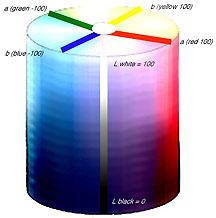Part Seven - Color Management
by Chuck Gardner
|
CIE L*a*b Color Space
The first step in the solving the dilemma of managing color was to find a way to measure it. In a ideal world there would be one standard unit of color measurement, but in that perfect world everybody would also use the same currency. Unfortuately that is not the case and there are many different color "currencies" in circulation. But, as with currency exchange there is a benchmark color measurement system which like the dollar all the rest are measured against. In the early part of the 20th Century A.H. Munsell created the concept of three dimensional "color space" to describe the properties of color in terms of hue, value, and chroma. In 1931 the Commission International d' Eclairage (CIE), established the range of human color vision the range of color or gamut an average "standard observer" could perceive. It refined Munsell's concept of color as a three dimensional into a measuring system which is now used as the benchmark for all color management systems. This benchmark "color space" called CIE L*a*b (also CIE Lab ). The CIE L*a*b model for color is a bit difficult to grasp at first glance because it isn't based on RGB or CYMK color. Instead it measures the range of color a human can perceive color by three criteria:  a) how green or red is it? Since green and red are
opposite each other on the color wheel if something is 100% green, it must
therefore be 0% red. The "a" channel contains information on the
relative balance of green and red in the color. A pure
green has a value of -100 and a pure red +100. a) how green or red is it? Since green and red are
opposite each other on the color wheel if something is 100% green, it must
therefore be 0% red. The "a" channel contains information on the
relative balance of green and red in the color. A pure
green has a value of -100 and a pure red +100.
b) how blue or yellow is it? Since blue and yellow are opposite each other on the color wheel, if a color is 100% blue, it must therefore be 0% yellow. The "b" channel contains on the relative balance of blue (-100) and yellow (+100). L) how bright is it? Because combinations of blue, yellow, red, and green can define all colors, the third component of CIE L*a*b is simply a black and white scale which defines the gray component of the color. The "L" channel is monochromatic and contains information on the luminance value of the color on a scale of 0 = black, to 100 = white. With this model color is a three dimensional space, with the darkest shades of the colors at the bottom, and the lightest at the top, with white at the very top in the center. The barrel-like representation of L*a*b color, while not technically accurate, illustrates how CIEL*a*b maps the color space a human can perceive. Goto Next Page > Goto < Previous Page Goto Class Outline Goto super.nova.org my home page. |